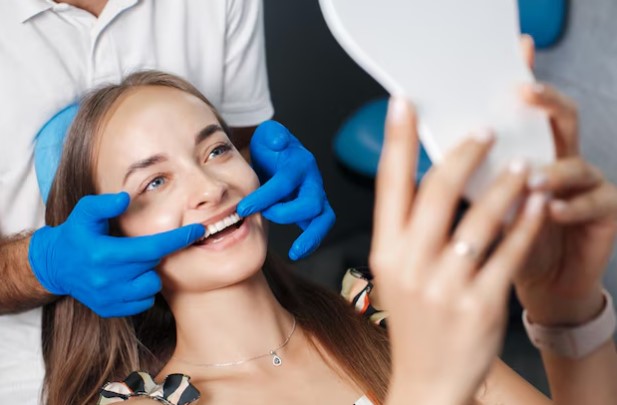Orthodontics is more than just about straightening teeth for aesthetic purposes. It plays a crucial role in enhancing your overall oral health by improving your bite. A proper bite, known as bite alignment, contributes to better chewing, speaking, and even self-esteem. Visiting an ortho dental clinic can help you achieve the perfect bite alignment and improve your oral health.
What Is Orthodontics?
Orthodontics is a specialized branch of dentistry that focuses on diagnosing, preventing, and treating dental and facial irregularities. These conditions are often referred to as malocclusions, which are problems with how your teeth and jaws fit together. The primary goal of orthodontic treatment is to correct these malocclusions, improving both the functionality and appearance of the teeth and jaw.
Orthodontists use a variety of devices, including braces, aligners, and retainers, to help guide the teeth into the correct position. These devices work by applying gentle pressure to the teeth over time, encouraging them to shift into a more natural alignment.
Understanding the Importance of Bite Alignment
When your teeth are misaligned, it can lead to several issues. The most common problem is a malocclusion, which refers to an incorrect bite. Malocclusions can be broadly classified into three categories:
- Overbite – When the upper teeth protrude too far over the lower teeth.
- Underbite – When the lower teeth extend beyond the upper teeth.
- Crossbite – When some of the upper teeth bite inside the lower teeth.
- Open bite – When the upper and lower teeth do not meet when the mouth is closed.
These bite issues not only affect your appearance but also your ability to chew, speak, and even breathe properly. Without proper bite alignment, you may experience discomfort, jaw pain, and difficulty eating. Over time, misaligned teeth can also cause excessive wear and tear on your teeth, leading to dental issues such as tooth decay, gum disease, and even tooth loss.
The Role of Orthodontics in Bite Improvement
Orthodontic treatment plays a significant role in improving bite alignment. By moving the teeth into their correct position, orthodontics can restore the functionality of your bite. The result is better oral health, increased comfort, and a more attractive smile.
When you visit an ortho dental clinic, the orthodontist will first assess your bite and determine whether treatment is necessary. This evaluation typically includes X-rays, impressions, and a comprehensive examination of your teeth and jaw.
Once a diagnosis is made, the orthodontist will develop a personalized treatment plan that may involve braces, aligners, or other dental appliances. The goal of the treatment is to gradually move the teeth into their correct position, improving both the functionality and appearance of your bite.
How Orthodontics Improves Your Bite
Orthodontic treatment works by applying gentle pressure to the teeth, gradually shifting them into their proper position. But how exactly does this process improve your bite?
Correcting Overbites and Underbites
Overbites and underbites are common malocclusions that can cause significant discomfort. When the upper teeth protrude too far over the lower teeth (overbite), or when the lower teeth extend beyond the upper teeth (underbite), it can interfere with normal biting and chewing.
Orthodontics uses braces or clear aligners to move the teeth into a more natural position. In the case of an overbite, the upper teeth are gradually repositioned so that they no longer extend too far over the lower teeth. Similarly, for an underbite, the lower teeth are moved into a better alignment with the upper teeth. This correction not only improves bite function but also reduces strain on the jaw, alleviating discomfort.
Fixing Crossbites
A crossbite occurs when some of the upper teeth bite inside the lower teeth. This misalignment can cause uneven wear on the teeth and lead to gum recession or tooth decay. Orthodontic treatment can help correct crossbites by repositioning the upper and lower teeth so that they align properly. This can improve your ability to chew and prevent future dental issues.
Treating Open Bites
An open bite is a condition where the upper and lower teeth do not meet when the mouth is closed. This can make it difficult to chew certain foods and may result in speech difficulties. Orthodontic treatment can correct an open bite by shifting the teeth into a more functional position. This alignment allows the upper and lower teeth to come together properly, improving bite function.
Benefits Beyond Aesthetic Appeal
Orthodontics not only improves the appearance of your smile but also enhances your overall health and well-being. Here are some key benefits of orthodontic treatment for your bite:
- Improved Chewing and Digestion: A proper bite makes it easier to chew food effectively, aiding in better digestion. When teeth are properly aligned, the pressure from chewing is distributed evenly, reducing the risk of excessive wear and tear on individual teeth.
- Better Speech: Misaligned teeth can affect speech patterns, causing lisping or difficulty pronouncing certain words. By correcting bite issues, orthodontics can help improve your ability to speak clearly.
- Reduced Jaw Pain: Misaligned teeth and jaws can cause strain on the muscles and joints of the face, leading to jaw pain or even temporomandibular joint (TMJ) disorders. Orthodontic treatment can help alleviate this discomfort by improving bite alignment and relieving pressure on the jaw.
- Prevention of Dental Issues: Properly aligned teeth are easier to clean, which reduces the risk of cavities, gum disease, and tooth loss. By improving your bite, orthodontics can help maintain the long-term health of your teeth and gums.
The Process of Orthodontic Treatment
Orthodontic treatment typically involves several stages, each of which plays a crucial role in improving your bite. Here’s a breakdown of what to expect during the process:
1. Initial Consultation and Assessment
Your journey towards a better bite begins with a consultation at an ortho dental clinic. During this visit, the orthodontist will evaluate your bite, take X-rays, and make impressions of your teeth. Based on this assessment, the orthodontist will develop a customized treatment plan tailored to your needs.
2. Placement of Braces or Aligners
Once your treatment plan is developed, the next step is the placement of braces or clear aligners. Braces are typically made up of metal brackets, wires, and elastics that work together to move the teeth into their proper position. Clear aligners, on the other hand, are removable trays that gradually shift the teeth without the need for metal hardware. The orthodontist will choose the best option based on your specific needs and preferences.
3. Ongoing Adjustments and Monitoring
Orthodontic treatment is not a one-time procedure. Over the course of several months or years, you will need to return to the clinic for regular adjustments. These adjustments involve tightening the braces or changing the aligners to ensure that the teeth continue to move into the correct position. The orthodontist will closely monitor your progress and make any necessary adjustments along the way.
4. Retainers and Post-Treatment Care
Once your teeth have reached their desired position, the orthodontist will remove the braces or aligners and provide you with a retainer. Retainers are custom-made devices that help keep your teeth in place after treatment. Wearing a retainer as instructed is crucial to maintaining the results of your treatment.
When to Consider Orthodontic Treatment
While many people choose to undergo orthodontic treatment for cosmetic reasons, there are several signs that you may need to consider orthodontics for bite improvement:
- Difficulty chewing or biting
- Speech issues caused by misalignment
- Jaw pain or discomfort
- Teeth that are overcrowded or spaced too far apart
- Clicking or popping sounds in the jaw
If you experience any of these issues, it’s essential to consult with an orthodontist to discuss your treatment options.
Conclusion
Orthodontics is a powerful tool in improving your bite and enhancing your overall oral health. By correcting malocclusions, orthodontic treatment can lead to better chewing, improved speech, and reduced jaw pain. Whether you’re looking to enhance the appearance of your smile or address functional issues, orthodontics offers a solution. For those seeking comprehensive dental care, including treatments like best root canal treatment, orthodontics can play an essential role in ensuring your smile is both healthy and beautiful.


